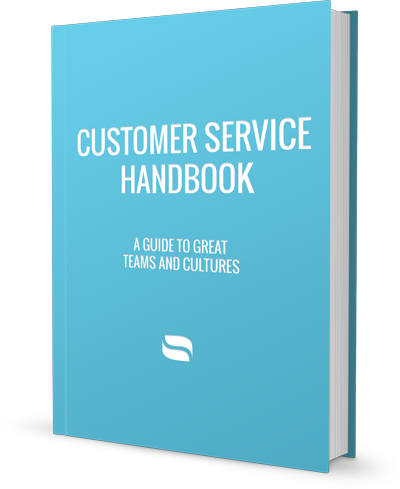







Delivering Happiness Part II
This is a part of a continuing series that is also available as a downloadable eBook here. We talked to 35 companies, including Stripe, Twilio, and Mailgun, to get a sense of what it takes to run a great customer support organization. While every company is different, there were some trends that we could identify as benchmarks for great customer support.
Create Happiness
Great customer support teams simply do an awesome job at making others and themselves happy. Delivering great experiences don't have to cost an arm and a leg either. Most of the happiness comes from within. It's about care, commitment, and empathy. These qualities are what makes a customer support team great.
Listen to customers and do your absolute best to picture yourself in their shoes.
Lauren @ Twice
"As our Community Manager, I'm responsible for ensuring that each customer gets a positive experience to write home about. When an issue arises, I'll do whatever I need to do in order to gain that customer's trust back. I make it my mission to make sure that problems are not only resolved but also turned into pleasant experiences. It makes a huge difference when they know that you're not only going to fix things but that you genuinely care about making them happy! Many times customers feel better just knowing that the apology they're receiving is genuine and they understand that we aren't taking advantage of them."
Christie @ Outright
"I'm always attached to my email to make sure I'm on top of our customers' needs at any given moment. I try to make my emails quickly readable, easily understood, and imbued with the warmth you get when you're having a genuine conversation with someone. I always let customers know they can contact me if they have any other questions at all, and they really appreciate that I leave the door open for any other lingering queries. Including preventative details is also something I like to do where it makes sense."
Open Communication
Cut down on the number of loops teammates have to jump through just to get in touch with relevant people. Keep your internal communications channel as open as possible without intruding on others' privacy and priorities.
Michael @ Stripe
"Customer support teams should be communicating constantly with other teams. Customer support issues are one of the most important sources of market research, right alongside sales barriers encountered by folks focusing on new users. It's the case that everyone working at Stripe is bringing something important. The people who focus on support do so because they care a lot about what our users' experiences are and want to communicate that back efficiently to make sure we're not leaving any potential improvement unnoticed."
Canned Foods Never Taste Good
Canned responses can be toxic for your small but growing customer support team and culture if not used responsibly. Many see canned responses as the best invention since sliced cheese. And who are we to refute that? Canned responses help you save time, power through your inbox, eliminate inconsistencies, and alleviate anger management issues quickly.
Jason @ Ideeli
"Canned responses are fantastic. Most often times though, they're not used properly. We encourage our agents to take pieces of it and turn it into a hybrid."
All these benefits might seem perfectly prescriptive at face value. But what you might not realize immediately through the over reliance of canned responses is that:
- People can smell bullshit. Canned responses will always look canned.
- Most canned responses are pre-written; meaning the context provided for every conversation is over extensive.
- Canned responses are, by definition, not short, succinct, personal, or direct messages. As a result, you're not taking advantage of the limited amount of time and attention you have with a customer.
- Your staff can easily become lazy, sloppy, and jaded. Nuances and creativity are easily overshadowed by the over reliance of canned responses.
If you're going to use canned responses, treat them not as readymade replies but as templates for each individual staff to expand on and add color to. These response templates should also be personal and not shared across the entire team.
Lauren @ Twice
"As for tools and processes, I couldn't live without canned responses. Not only does it add organization and uniformity, but having the basic skeletons of various responses prepped and ready for action leaves me extra time to add my own personality and really make an extra effort to connect with our customers. No one likes to feel like they're talking to a robot!"
Make Friends
Everyone on your team must have the ability to craft friendships. Encourage your staff to step outside the bounds once in a while to spark an off topic conversation with customers. The great thing is that you don't need to do it intentionally. Allow conversations to evolve. Roughly 20% of our conversations with users evolve in some way. Sometimes we'll chat about great pig-out spots in San Francisco, the ball game where Kobe just completely dominated, or a new meme that somehow made its way into our conversations.
Making friendly conversation not only helps foster healthy relationships, it can also diffuse angry and sticky situations. True story: we accidentally double charged a user for the month of December. The customer wrote an angry but polite email documenting our fault, complete with a partial screen shot of his credit card statement. In addition to the duplicate charge, there was also a popular pizzeria transaction. After we reversed the charge and apologized, we asked the customer whether the pizza was any good. It was getting late, we were hungry, and we hadn't had pizza in a while. The customer replied: "Ha ha. Their stuffed crust is awesome. It's also my weakness :)"
Courtney @ Eventbrite
"Since everyone came from support, they become best friends with people from other teams. No matter which team they go back to, that connection and bond is always present. Every team benefits from that. Support is close to everyone's hearts for that reason at Eventbrite."
Lauren @ Twice
"Maintaining an authentically friendly and positive attitude can diffuse even the most disgruntled of customers, and it's always my favorite tool to use. It's really hard for a customer to stay mad when you're not only solving their problem but also relating to them personally and adding your sense of humor, too! People know when you aren't being genuine with them, and a fake half-laugh is hurting more than it's helping. Building a relationship with people to the point where they feel comfortable coming to you with their problems is essential to providing a high level of customer service."
Help Each Other
Engaged and informed customers are your best customers. In addition to you supporting them, give your customers opportunities to support each other. Well-versed and savvy customers love to help whenever they can.
Christie @ Outright
"Our philosophy for having a community area was to remove the support team as a bottleneck. If customers want to get answers even faster than we can reply, we need to make sure they can achieve that and find answers themselves."
A community comments system will give customers the ability to share thoughts and ideas in short blurbs. Having a comments system gives you more control over the topics being discussed. Post new content, best practices, questions, polls, and other interesting factoids to pique your customers' reactions.
Michael @ Stripe
"While we try to surface as much information as possible to the documentation or product level so that people aren't forced to write in, we're always happy to spend time talking with our users, digging in deep to figure out an integration, giving advice, or just generally having a good conversation."
Forums are great for organic customer support that fosters community-building. Active and passionate customers will often help others by posting neat tips, tricks, stories, and if you're lucky, hacks and workarounds. Many customers will make their way to forums to check out pinned tutorials and most frequently asked questions. Your customer support team should involve themselves in these discussions to monitor the climate.
Knowledge-Bases and FAQs are perfect for alleviating the pressures off your team as well. Document and publish most frequently asked questions, customer concerns, tutorials, and how-to's. Make your KB and FAQs accessible, prominent, and easy to navigate. You can also integrate a comments system for your KB and FAQ. If customers can easily access this repository of information, they might just hold off on sending you a message.
John Sviokla @ Harvard Business Review
"The economics of this type of customer care are superior to anything that can be done with internal resources alone. When I did an analysis of a customer service organization at IBM many years ago, the codification of solutions into a knowledge base shifted first call resolution from less than 60% to over 90%. Customers were happier."
Chapters
How's your customer support?
We build brilliant customer support software for companies like yours.
Stop wrestling with ticket numbers and start delighting customers with Reamaze, our cloud helpdesk.
We wrote the book on Customer Support
Literally.
Our book includes interviews with some of the top customer support organizations in the industry and shows you what it takes to deliver consistent, high-level support, whether you're a one person startup or a Fortune 500 enterprise.

Get our eBook under "Official Downloads"
Join thousands of teams using Reamaze to impress customers.
Find out how with a free account.
